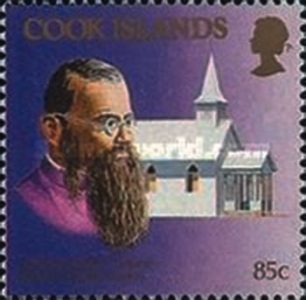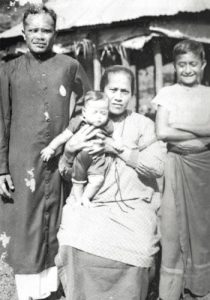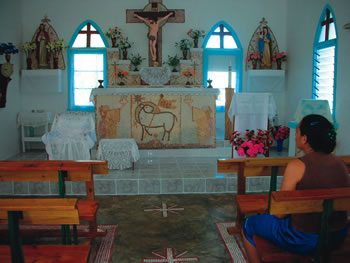How the Catholic Faith came to Pukapuka
Pukapuka is a small isolated island in the northern group of the Cook Islands.
I find the story of how the Faith came to this island especially moving because it involves some of our sisters who worked in Samoa early last century.
In 1913 a young man called Tangi-te Yua went from Pukapuka to work in Samoa. He contracted leprosy and was nursed by the sisters. He was so impressed by their love and kindness that he wanted to become a member of the religion which could inspire such heroic devotion. He became a Catholic, taking Patrisio as his baptism name.
Patrisio wrote to his father Ura, the government Resident Agent on Pukapuka, telling him about the sisters’ kindness, and his conviction that Catholicism was the true religion. Ura was a Protestant deacon and his knowledge of the Catholic faith was from Protestant missionaries – biased, and for the most part, wildly inaccurate.
When Ura preached about how he admired the Catholic religion his hearers became annoyed, accusing him of being a member of the Church of the Pope in Rome. He was told to stop preaching about Catholicism or to give up preaching altogether. Ura made a decision. He made a public declaration that he was a Catholic, and his extended family, 72 people in all, decided that they were Catholics too! Before he died Ura asked all the members of his family to promise that they would stay faithful to the Catholic Church.
In the early years of the Cook Islands’ mission, Fr Bernardin Castanié ss.cc visited Pukapuka and Nassau, a nearby island. He took copies of the Catholic newsletter – ‘Torea Katorika,’ which was first published in 1914 – and gave them to Ura to distribute.
When Ura died in 1929, his eldest son wrote to Fr Bernardin asking for more copies of ‘Torea,’ and he also requested that a priest be sent to baptise ‘the Catholics.’ There was no priest available, but Fr Bernardin wrote to Bishop Darnand sm in Samoa, asking him to send a priest to Pukapuka on one of the Burns Philp copra boats. Bishop Darnand had no priest to spare, but offered to take two married couples as students at the catechists’ school in Moamoa, Samoa.
On 29 August 1932 two couples – Reni and Kamo, and Karekura and Papani – arrived in Samoa on board the SS Makoa. They began their studies right away. They were baptized during the Easter ceremonies in 1933. Reni took the name of Petero, and Kamo the name of Maria-Matalena.
During the second year of his studies Karekura became ill and died. His widow, Papani, returned to Pukapuka. Petero and Maria-Matalena continued their training.
In May 1935 they returned to Pukapuka with their small child. They were busy every day instructing those who wished to be baptised as Catholics. Some time later Fr Blaise Gaucher sm travelled from Samoa to Pukapuka. He spent four days there, baptising, celebrating Mass and explaining the mysteries of faith to the people, including some curious Protestants. Reni (Petero) interpreted. There were 93 catechumens.
In 1937 Fr Ernest Lavrel ss.cc was able to visit Pukapuka on a Cook Islands’ Trading Company schooner. ‘With great joy’ he baptised 67 well-instructed converts. Maria-Matalena and Petero were godparents.
In 1958 Pukapuka welcomed its first resident priest, Fr Benitio Emmen ss.cc. He remained there until 1974 and was followed by Fr Philip Tuohy, a New Zealander, and Fr Marino Kruitwagen ss.cc. There has been no resident priest in Pukapuka since 1983. Two catechists and their wives minister there.
The story of how the Catholic faith came to Pukapuka is an amazing and beautiful one. The lives of the sisters who nursed the leprosy patients long ago were truly ‘hidden away with Christ in God.’ The sisters were truly ‘hidden and unknown.’ But, as we see, God chose them – among others – as his witnesses and instruments so that the people of Pukapuka, a small island lost in the Pacific, would come to know him in the Catholic Church.
Sources: Archives of the Catholic Diocese of Rarotonga; Archives of the Catholic Diocese of Samoa.




 Entries(RSS)
Entries(RSS)